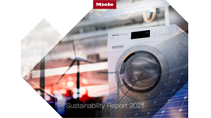Press releases
Why the Scout RX1 never skips a single corner
Gütersloh/Bielefeld, March 25, 2014
No. 060/2014
New Miele robovac: Tested and co-developed in Bielefeld / In-house laboratories for navigation, suction performance, dust pick-up and product durability
In developing the Scout RX1, Miele engineers at its Bielefeld plant have created a virtual environment dedicated to optimising robot vacuum cleaners. And, in their work, they can rely on almost 90 years of past experience: Miele developed its first vacuum cleaners at its second-largest production plant as early as 1927.
To meet precisely formulated requirements, Miele engineers set up a navigation test room in their laboratory which represents a true-to-life living room. Valuable support was provided by the University of Bielefeld which has an excellent reputation in the field of robotics. Together, the two partners put their scientific experience and insights into practice.
Miele's robovac is under the strictest surveillance in the navigation test room. Cameras track its progress as it traverses the room, carefully monitoring its behaviour around furniture, below tables and chairs, along walls and in corners. The evaluation of data captured and proposals on optimisation are relayed without delay to the software developers for implementation. The outcome of this process was the intelligent systematic navigation system which includes programmes with names such as 'Corner' or 'Turbo'. As these terms imply, the former is for cleaning difficult-to-access areas while the latter is particularly fast.
And, of course, the subject closest to Miele's own heart is quality and durability. In specially prepared endurance test rooms, ten appliances are regularly left to run around the clock in separate cubicles. In each case, the appliances have different tasks to perform: Several are connected to an external power supply and run virtually uninterruptedly while others are battery-powered and put through their paces in 'Test' mode in 'standard' L-shaped cubicles. Others, again, are confined to L-shaped rooms with a steep step where they are powered by their rechargeable batteries in 'Test' mode. In this mode, the robovacs return to their base only briefly after completing the cleaning of the room in order to monitor docking precision before starting their cleaning work all over again. They only return to the docking station for recharging when the rechargeable battery is almost flat.
And, naturally, meticulous records are kept of the hours worked in endurance tests.
Appliances are expected to work for at least 1500 hours without developing the least fault, although testing goes on for much longer. The longest-distance runner has already clocked up more than 3000 hours of operation – and is still working to perfection. Furthermore, endurance testing also allows conclusions to be drawn regarding the condition of other machine components such as tyre tread and the suction system which may need to be modified to meet requirements.
The Bielefeld laboratory also covers suction performance and dust pick-up in similar tests to those to which the robovac's 'big brothers' are subjected, whereby test apparatus has been specifically altered to address the special aspects of robot vacuum cleaners. Although robovacs are designed for convenient cleaning 'inbetween times', Miele nevertheless applies the same standards relating to thoroughness and the quality of results. And an entirely new safety concept was devised specifically for the Scout RX1: Before starting the machine, a check is performed on the anti-fall sensors in order to ensure that they are in proper working order. Devices such as these were developed by Miele's Bielefeld-based experts in close collaboration with a young Korean company which specialises in vacuum cleaner robotics. This company engineered the requirements formulated by Miele into the Scout RX1.
And, to ensure that the Scout RX1 meets Miele standards in every respect, not only the machines themselves are inspected but also the suppliers and individual components right through to the packaging. After all, the latter is subjected to a variety of climatic conditions - just like the machines themselves. Auditing of production at the supplier/manufacturer's facilities is just as much a part of the range of duties of the Bielefeld plant as functional and endurance testing and product documentation.
(673 words, 4.504 characters incl. spaces)
Company profile: Miele is the world leader in the field of premium domestic appliances including cooking, baking and steam-cooking appliances, refrigeration products, coffee makers, dishwashers and laundry and floorcare products. This line-up is augmented by dishwashers, washer-extractors and tumble dryers for commercial use as well as washer-disinfectors and sterilisers for use in medical and laboratory applications (Miele Professional). The company, founded in 1899, has 8 production plants in Germany and one plant each in Austria, the Czech Republic, China and Romania. 2012/13 turnover amounted to approx. EUR 3.15 bn with sales outside Germany accounting for 70%. Miele is represented with its own sales subsidiaries and via importers in almost 100 countries. The Miele company, now in the fourth generation of family ownership, employs a workforce of around 17,250 with two-thirds in Germany. The company headquarters are located in Gütersloh/Westphalia, Germany.
Download as PDF
Your contact


